Developer Guide
Done by (CS2103-T14-2): Donavan Lim, Marcus Lee Eugene, Chong Sidney, Dinesh S/O Magesvaran, Prabhakaran Gokul
- Description
- Design
- Implementation
- Documentation, logging, testing, configuration, dev-ops
- Appendix A: Challenges Faced
- Appendix B: Product scope
- Appendix C: User stories
- Appendix D: Use cases
- Appendix E: Non-Functional Requirements
- Appendix F: Glossary
- Appendix G: Instructions for manual testing
- UI Mockup
Description
The Food Diary is a desktop app for managing food diary entries, optimized with a Command Line Interface (CLI) and packaged with a Graphical User Interface (GUI).
The Food Diary caters to food-passionate NUS students who would ideally benefit from keeping records of food options tasted in the vicinity of NUS.
The Food Diary will allow students to save time and effort when finding places to eat around the NUS vicinity. The Food Diary especially caters to students mainly on 4 aspects:
- The ability for users to save food diary entries for future reference.
- The ability for users to find entries based on specific fields.
- The ability for users to have multiple food reviews for a food place.
- The option for users to use Commands / Ui to perform some tasks quickly.
Design
Architecture
 The Architecture Diagram given above explains the high-level design of the App.
Given below is a quick overview of each component.
The Architecture Diagram given above explains the high-level design of the App.
Given below is a quick overview of each component.
Main has two classes called Main and MainApp. It is responsible for,
- At app launch: Initializes the components in the correct sequence, and connects them up with each other.
- At shut down: Shuts down the components and invokes cleanup methods where necessary.
Commons represents a collection of classes used by multiple other components.
The rest of the App consists of four components.
-
Ui: The User interface (ie. Ui) of the App. -
Logic: The command executor. -
Model: Holds the data of the App in memory. -
Storage: Reads data from, and writes data to, the hard disk.
Each of the four components,
- defines its API in an interface with the same name as the Component.
- exposes its functionality using a concrete
{Component Name}Managerclass which implements the corresponding API interface mentioned in the previous point.
For example, the Logic component (see the class diagram given below)
defines its API in the Logic.java interface and exposes its functionality
using the LogicManager.java class which implements the Logic interface.

How the architecture components interact with each other
The Sequence Diagram below shows how the components interact with each other for the scenario
where the user issues the command addon 1 re/i like this food.

The sections below give more details of each component.
Ui component
 API:
API: Ui.java
- The
Uiinterface consists of aMainWindowthat is made up of smaller Ui parts. Namely, from top to bottom these are:CommandBox,ResultDisplay,EntryListPanel,StatusBarFooter. - The
MainWindowalso initialises 3 other windows that are used in The Food Diary. Namely, these are:HelpWindow,ViewWindowandReviseWindow. - All of these Ui parts and windows, including the
MainWindow, inherit from the abstractUiPartclass. - In addition, the
Uicomponent also uses the JavaFX Ui framework. The layout of these Ui parts are each defined in their corresponding.fxmlfiles that can be loated in thesrc/main/resources/viewfolder. - For example, the layout of the
HelpWindowis specified in theHelpWindow.fxmlfile. - A universal styling theme is applied to all components, and the styling is defined in 2 files:
DarkTheme.cssandExtensions.css. Both are located in thesrc/main/resources/viewfolder. - Images/icons used throughout the app windows are located in the
src/main/resources/imagesfolder.
- The
Uicomponent executes user commands using theLogiccomponent. - The
Uicomponent also listens for changes to theModeldata, to which the Ui will be updated to reflect the modified data.
Logic Component
 API:
API: Logic.java
-
Logicuses theFoodDiaryParserclass to parse the user command. - This results in a
Commandobject which is executed by theLogicManager. - The command execution can affect the
Model(e.g. adding an entry to the Food Diary). - The result of the command execution is encapsulated as a
CommandResultobject which is passed back to theUi. - In addition, the
CommandResultobject can also instruct theUito perform certain actions, such as displaying help to the user.
Given below is the Sequence Diagram for interactions within the Logic component for the
execute("addon 1 re/Good") API call.
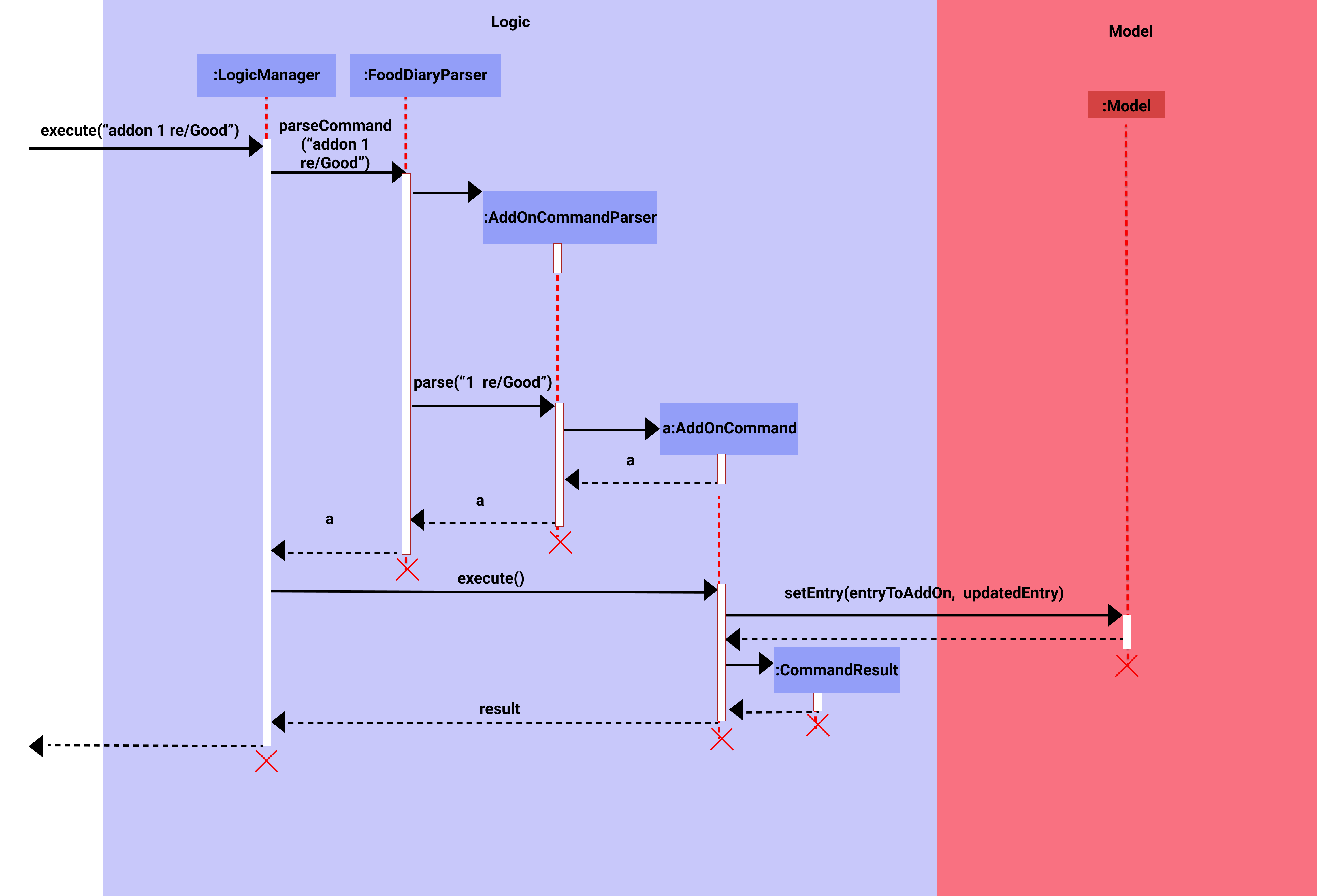
Model Component

API : Model.java
The Model,
- stores a
UserPrefobject that represents the user’s preferences. - stores the user’s food entries data.
- exposes an unmodifiable
ObservableList<Entry>that can be ‘observed’ e.g. the Ui can be bound to this list so that the Ui automatically updates when the data in the list change. - does not depend on any of the other three components.
Storage Component

API : Storage.java
The Storage component,
- can save
UserPrefobjects in json format and read it back. - can save the food diary data in json format and read it back.
Common classes
- Classes used by multiple components are in the fooddiary.commons package.
- There are primarily 3 folders of classes classified under common classes. Namely, these are:
IndexExceptionsUtility
- In general, these classes are responsible for the processing of the app’s logging information, GUI settings, error messages thrown, and file management etc.
Notably:
- The
GuiSettingclass in theIndexfolder contains methods that process all the GUI settings of the app, and is essential in allowing the app to restore back the GUI window settings upon reopening the app. - The
LogCenterclass in theIndexfolder contains methods that process the loggers and handlers responsible for logging useful information on the user’s usage of the app for the developer’s use and understanding.
Implementation
This section describes some noteworthy details on how certain features are implemented.
AddOn Feature
The AddOn feature allows the user to add review(s) and/or a price to a single entry of a food place. This will be useful for users who frequently visit a particular place and would like to enter their reviews, and the price spent on each visit. The reviews are added to the user specified entry, and the price added on will be reflected as a price range of the user’s spending history (e.g. if the current entry has a price of $5, adding on a price of $10 will update the current price of $5 to a price range of $5-$10).
Given below is an example usage scenario:
Step 1. The user launches The Food Diary application. Data will be loaded from the storage to the application memory.
The FoodDiary will be populated with a list of Entry, each contains: Name, Address, Price
, Rating, Review, TagCategory and TagSchool.
Step 2. (Optional) The user executes list command to list out all the entries and select the entry to add on details.
Step 3. The user executes addon 1 re/I like this food a lot! p/7 command to add on details to an existing entry.
The command contains values such as a “I like this food a lot!” review and a price value of $7.
Step 4. If the parameters entered by the user is valid, the application will create a new entry and stores the information in Model and Storage.
Else, the FoodDiary will display an appropriate error message.
The following sequence diagram shows how the AddOn feature works:

The following activity diagram summaries the flow of events when a user executes the addon command:
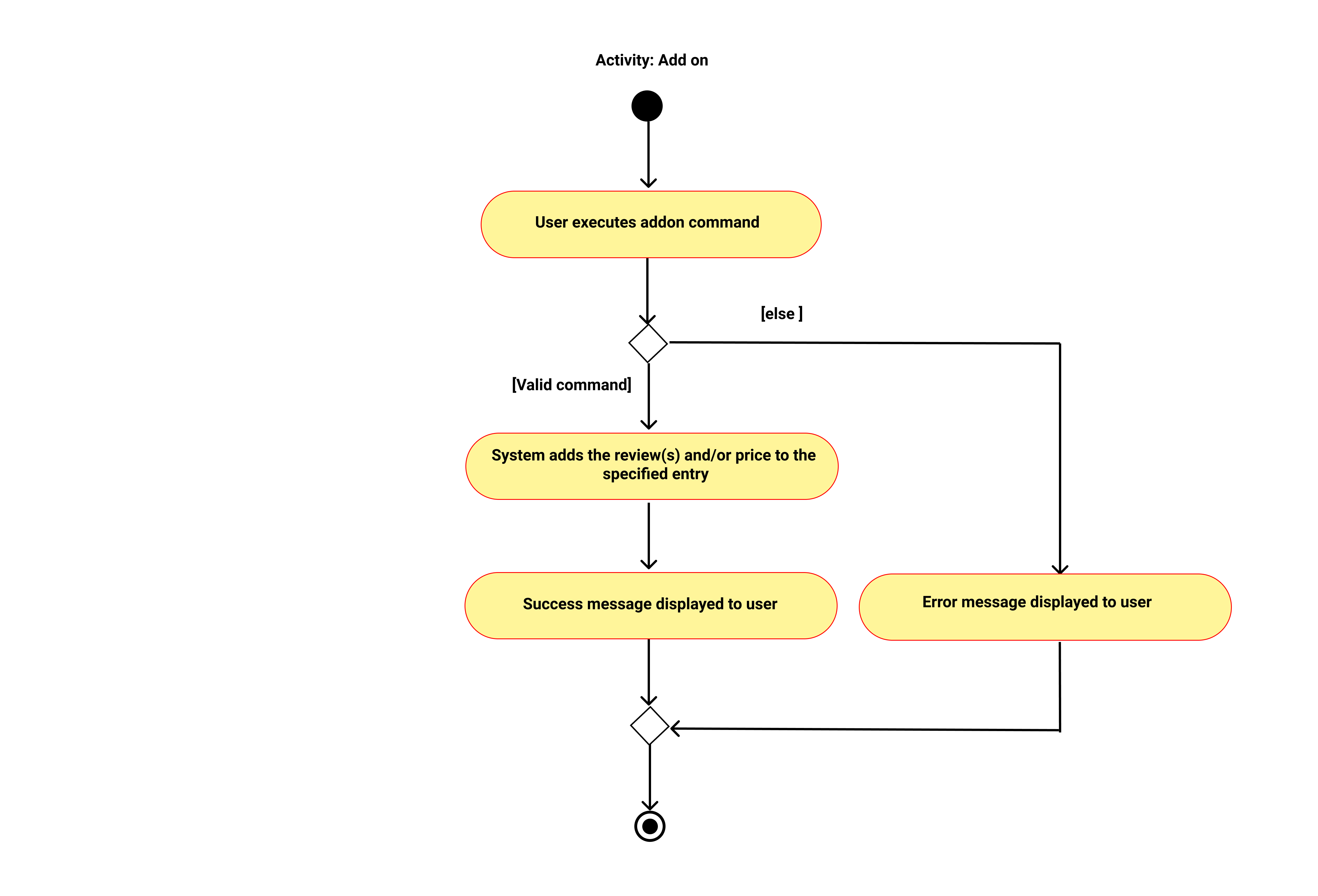
Design Consideration
Aspect: Whether entry class should have a list of Reviews or a single Review as an attribute (for adding on reviews to an existing entry)
-
Alternative 1 (current choice): Entry containing a list of Reviews as an attribute.
- Pro: Looks neater from a design perspective, as additional reviews added on will just be appended to the list of reviews. Easily extendable in the future (e.g. deleting a specific review in an entry).
- Con: A lot of refactoring will be needed. Time-consuming.
-
Alternative 2: Entry containing a single Review attribute.
- Pro: Easy to implement, as additional reviews can be concatenated as a string to the current review
- Con: This cannot be easily extended in the future (e.g. the capability to delete a specific review in an entry without deleting other reviews).
List Feature
The List feature allows a user to list all entries that they have keyed in thus far. This will be useful when a user wants an overview of all the entries he/she has keyed in previously.
Given below is an example usage scenario:
Step 1. The user is in the Food Diary application.
Step 2. The user executes list. The Food Diary application lists all the entries in the user’s database.
Each Entry contains the Name, Address, Price, Rating, Review, TagCategory and TagSchool.
This feature was brought over to The Food Diary from AB3.
There were not many changes apart from modifying it to list
entries instead. Similar to other commands, MainWindow#executeCommand() runs and LogicManager#execute()
will be called to parse the user input in FoodDiaryParser#parseCommand().
The parsed command will be identified as a list command.
Find Feature
The Find feature allows a user to find entries that match ANY of the keyword(s) provided by the user. This enables the user to easily sieve out all the entries that meet any of the requirement(s) the user is looking for, which will be useful when deciding where to eat.
This feature is implemented through the find command, where the user will provide a list of keyword(s) that
they would like the FoodDiary to utilise to search through the various fields from the FoodDiary entries.
The fields that can be searched through include Name, Rating, Price, Address, TagCategory and
TagSchool. Using the provided list of keywords, the FoodDiary will search through all the specified searchable
fields of all entries, and return all entries that match at least one of the keywords provided. The Ui will then
be updated to display the list of entries that were returned as a search result.
Given below is an example usage scenario:
The user wants to find good food places within NUS.
Step 1: User enters the command find 5/5.
Step 2: The food diary displays all entries that have a rating of 5/5.
Step 3: User is considering whether to visit the food place in the first entry, and uses the view command view 1
to look through that particular food entry to see past reviews.
Step 4: User decides to visit that particular food place.
To better understand how the Find feature works, refer to the diagrams provided for the FindAll feature, as the implementation is largely the same.
Design Considerations
Aspect: Whether the syntax used for the find command should be similar to the add command
-
Alternative 1 (current choice): Implement the
findcommand without using similar syntax to theaddcommand (eg.find 5/5 $4-6 westerninstead offind ra/5 p/4-6 c/western).- Pro: Less syntax required, making the command more user-friendly (Important as the
findcommand will likely be executed by the user many more times as compared to theaddcommand). - Con: Makes the implementation less standardised across different commands.
- Pro: Less syntax required, making the command more user-friendly (Important as the
-
Alternative 2: Implement the
findcommand by using similar syntax as theaddcommand.- Pro: Makes the implementation more standardised across different commands.
- Con: Greatly slows down the efficiency of performing searches on the FoodDiary, which will negatively impact the user experience.
Aspect: How the user-input keywords for the Rating and Price fields should be implemented
-
Alternative 1 (current choice): Implement the Rating and Price fields with additional syntax (eg. Rating
implemented as
RATING/5instead ofRATING, and price implemented as$PRICEor$PRICE-PRICEinstead ofPRICEorPRICE-PRICE).- Pro: More intuitive keywords for the user to type out when performing their search.
- Con: More typing is required, with additional syntax that needs to be strictly followed.
-
Alternative 2: Implement the Rating and Price fields without additional syntax.
- Pro: Keywords can be typed out faster, makes performing searches more efficient.
- Con: Possibility of user getting back results for Rating when finding for Price, or getting back results for Price when finding for Rating, which are both unintended consequences.
FindAll Feature
The FindAll feature allows a user to find entries that match ALL the keywords provided by the user. This enables the user to easily sieve out all the entries that meet every single requirement the user is looking for, which will be useful when deciding where to eat.
This feature is implemented through the findall command, where the user will provide a list of keywords that
they would like the FoodDiary to utilise to search through the various fields from the FoodDiary entries.
The fields that can be searched through include Name, Rating, Price, Address, TagCategory and
TagSchool. Using the provided list of keywords, the FoodDiary will search through all the specified searchable
fields of all entries, and return all entries that match all the keywords provided. The Ui will then
be updated to display the list of entries that were returned as a search result.
The FindAll feature is similar to the Find feature. The Find feature finds for all entries that meet at least one of the given keywords, while the FindAll feature only finds for entries that meet all the given keywords.
Given below is an example usage scenario:
The user wants to find good food places within NUS that are within their budget, from a specific food category.
Step 1: User enters the command findall 5/5 $0-10 western.
Step 2: The food diary displays all entries that have a rating of 5/5, a price range that contains food options $10 or below, and that have western food available.
Step 3: User is considering whether to visit the food place in the first entry, and uses the view command view 1
to look through that particular food entry to see past reviews.
Step 4: User decides to visit that particular food place.
The following sequence diagram shows how the FindAll feature works:
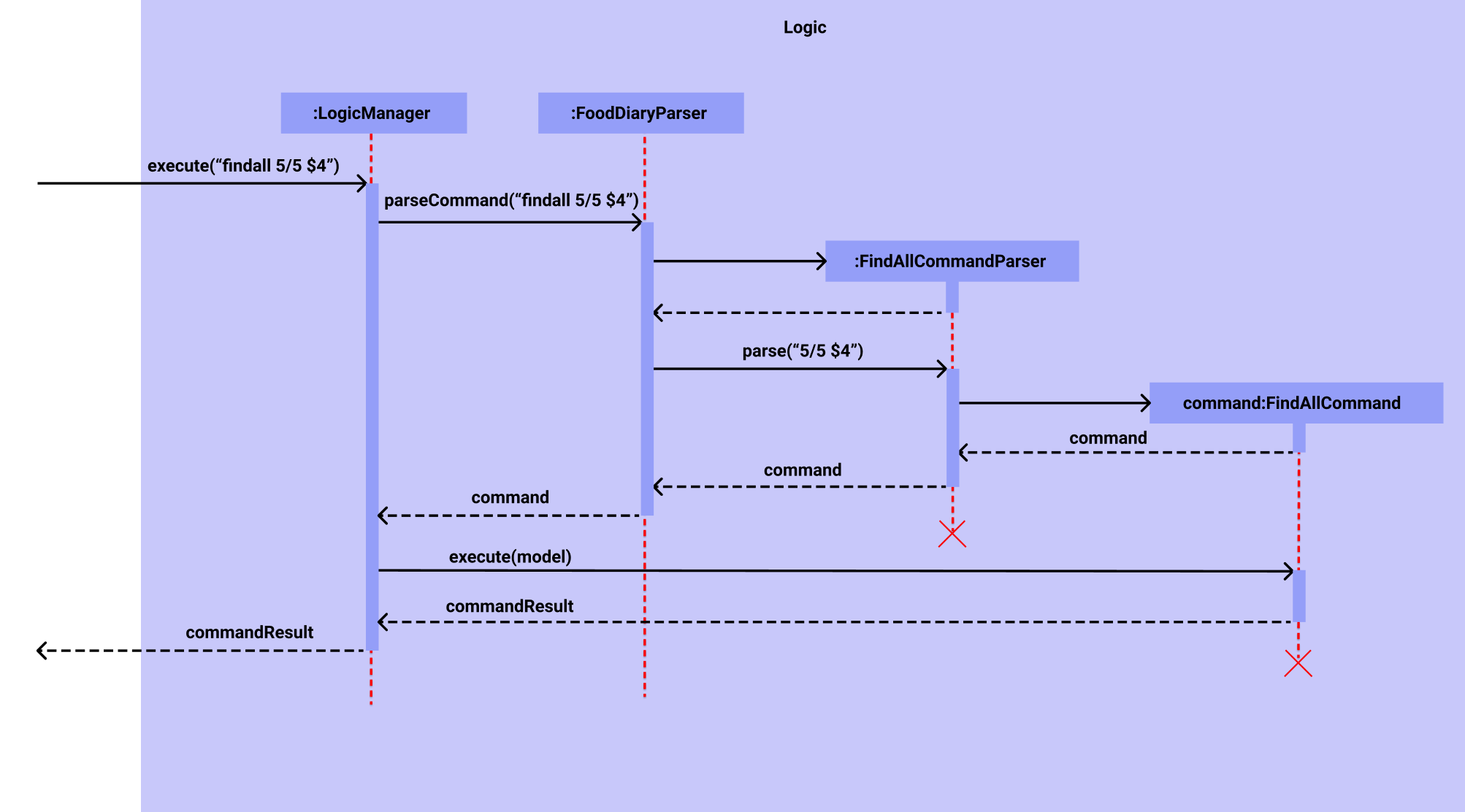
The following activity diagram summarises the events that take place when a user executes the findall
command:
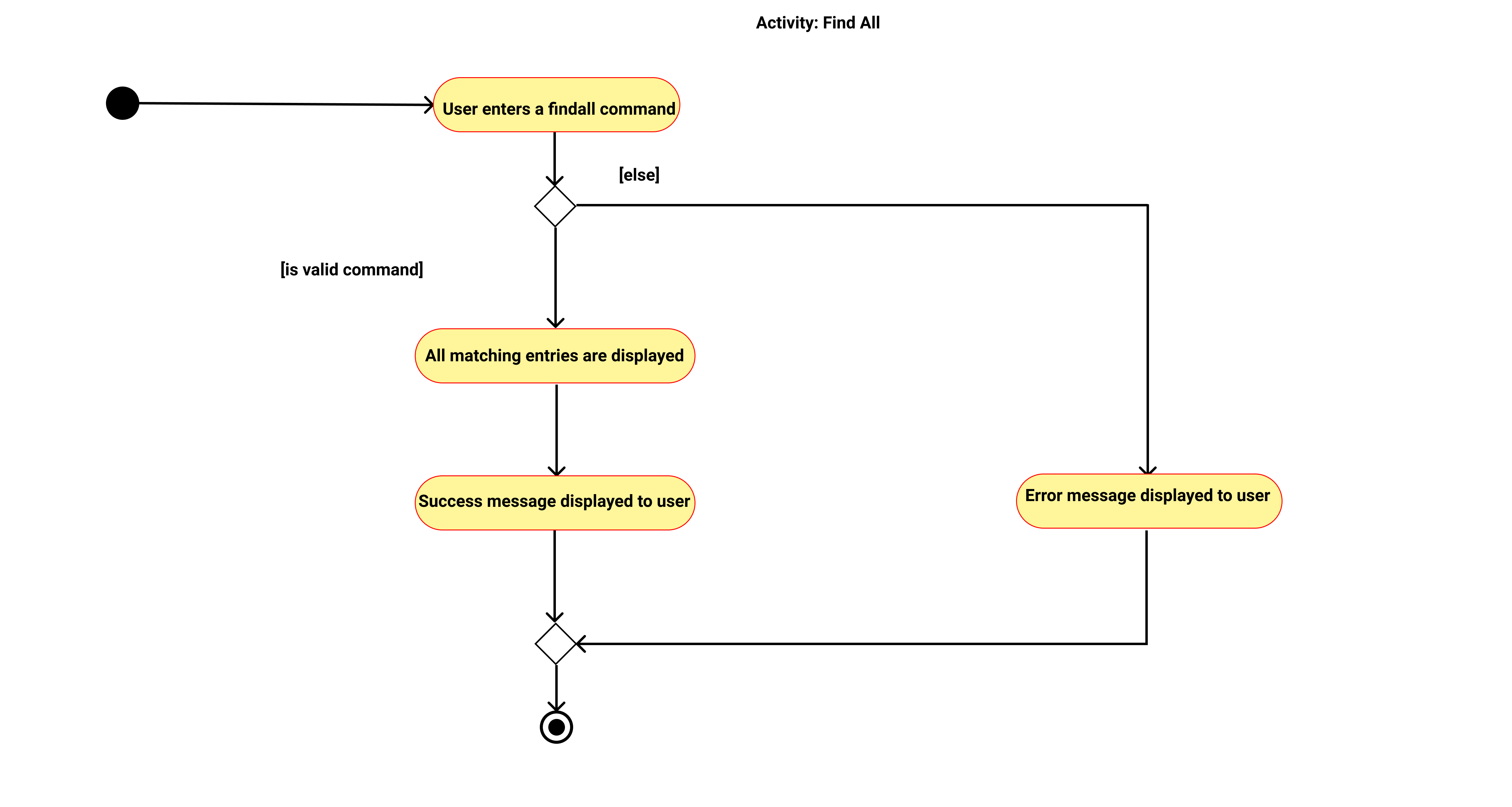
Design Consideration
Aspect: Whether the FindAll feature should be implemented as a separate command from the Find feature
-
Alternative 1 (current choice): Implement the FindAll feature as a separate command.
- Pro: Easier to implement, and more user-friendly as less syntax is required.
- Con: User has to utilise 2 different commands despite them both performing a similar search function.
-
Alternative 2: Implement the FindAll feature using the same command as the Find feature.
- Pro: User can carry out all searches using only one command, which makes the features fit together better than the first alternative.
- Con: Much harder to implement, and less user-friendly as more syntax is required due to the user needing to specify the method of search between the Find and FindAll features that they would like to use to perform their search.
Revise Feature
The Revise feature allows a user to quickly edit different sections of an entry. It is often misunderstood to be mutually exclusive with the Edit feature or the slower alternative of it. This feature shines when a user wishes to edit while also adding into multiple sections in an entry. The Edit and AddOn features are still necessities for making quick and small chanegs to an entry.
The command opens an additional window when a user enters the command in the Ui, the command will be passed into
MainWindow#executeCommand(), in which Logic#execute() calls LogicManager#execute(),
which parses the user input via FoodDiaryParser#parseCommand().
The user input will be parsed as a ‘Revise’ command and executed to retrieve all the details related to the specified entry.
With a separate window for revision of the entry, a user can easily make changes to the sections all at once.
With the revise button, all the changes made are passed into the MainWindow#executeCommand(), which makes its way to
ReviseCommand#revise() which calls MainWindow#executeCommand() with the content of each section concatenated with its
prefix and the EditCommand.
The following sequence diagram shows how Revise feature works:
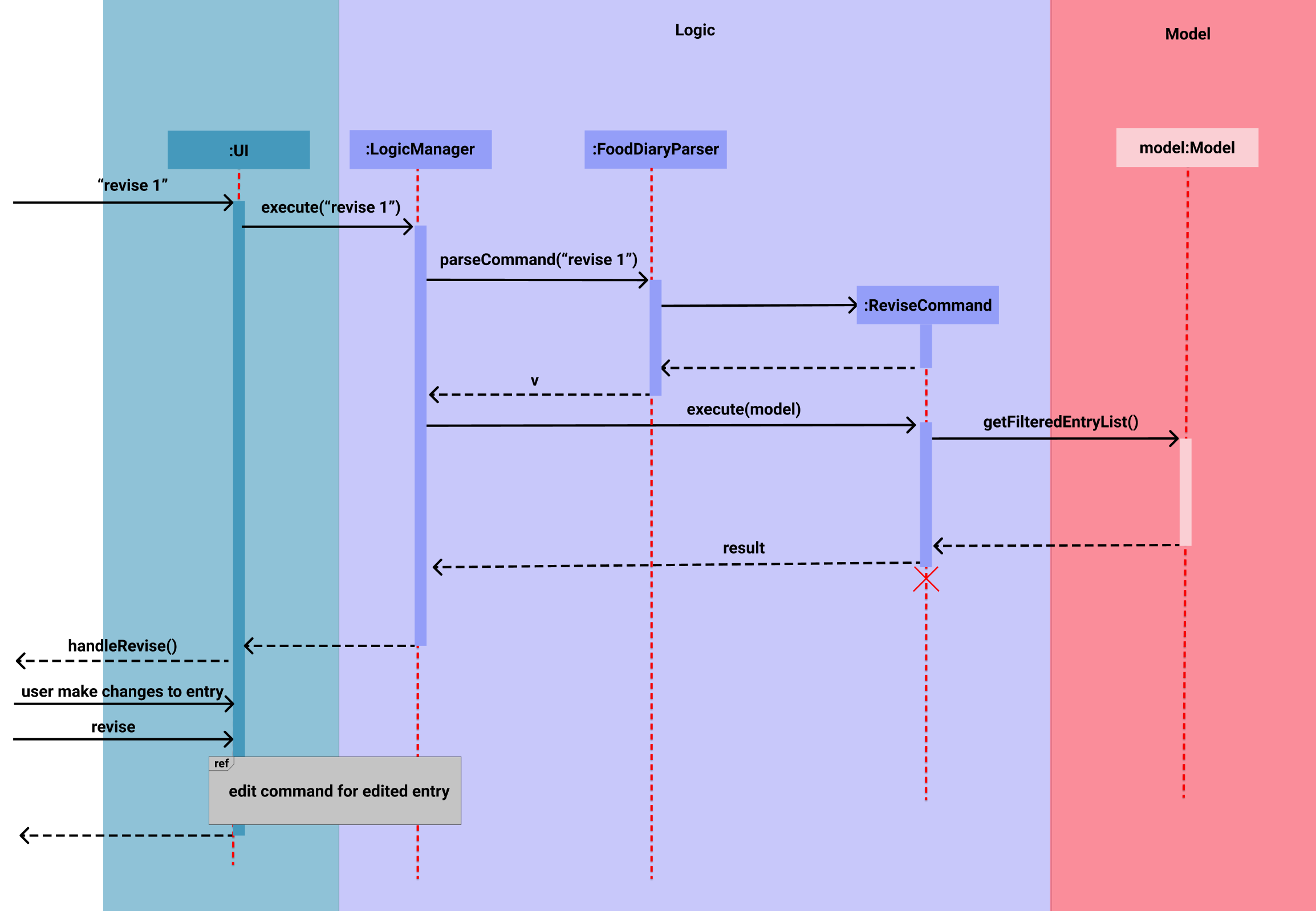
The following activity diagram summarises the events that take place when a user executes the revise command:
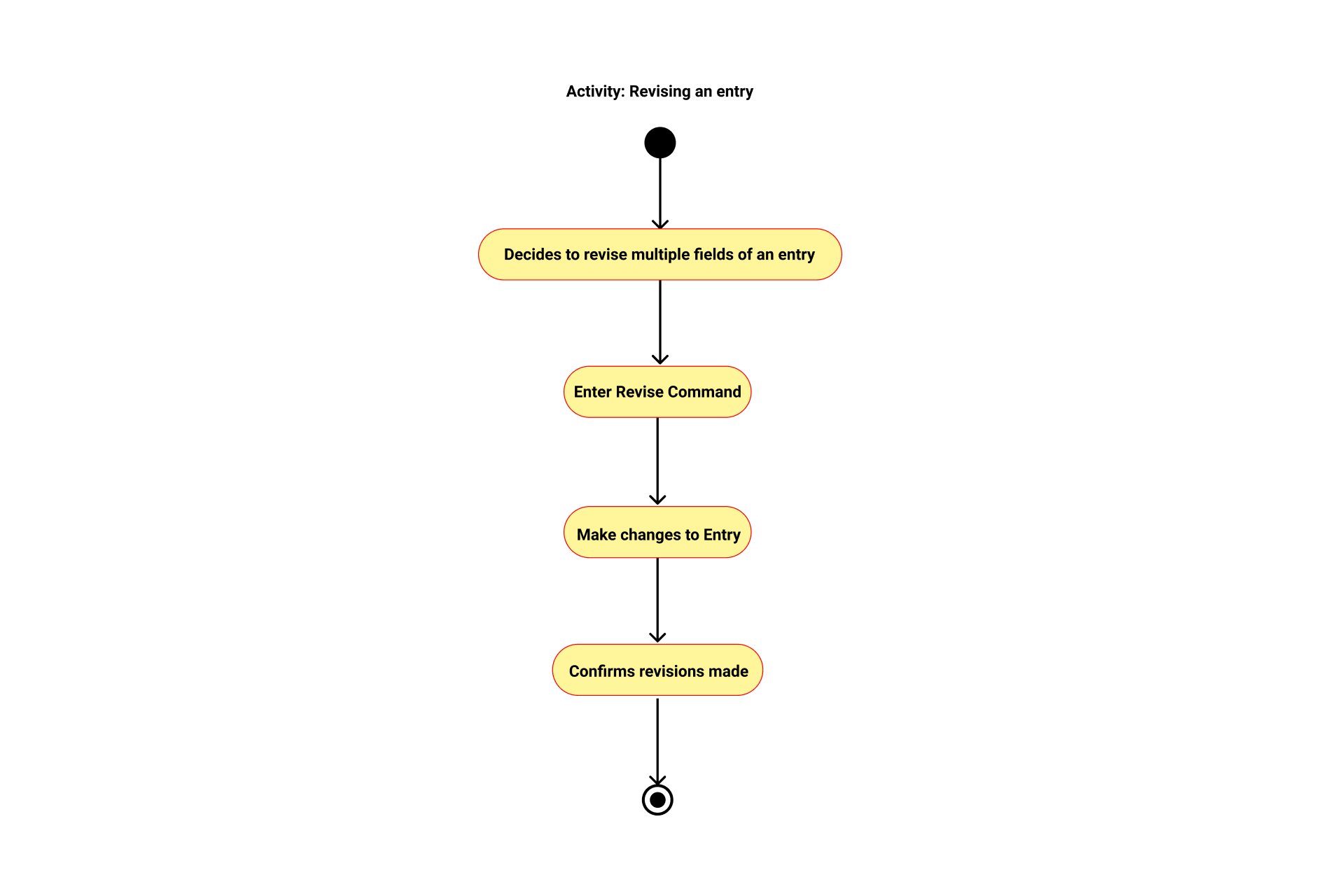
Design Consideration
Aspect: Whether to revise entry in command line or in a new Ui window
-
Alternative 1 (current choice): Revise entry in a new Ui window.
- Pro: View all details of an entry and easily revise them with keyboard shortcuts.
- Con: Revise is not done purely in command line, but rather in a separate Ui window.
-
Alternative 2: Revise entry in command line.
- Pro: Revise is purely done in the command line.
- Con: For entry with lengthy details, typing in the full command will flood the command line text field and pose a major inconvenience for users to revise the entry specified.
Edit Feature
Implementation
At its core, the edit feature allows a user to edit multiple fields pertaining to the entry specified by its index,
in a single edit command. The edit feature is the fundamental feature for editing an entry, and it is recommended
for users to use it if minor changes to an entry are to be made, typically caused by a spelling mistake or typo.
As such, the edit feature runs solely via the command typed in the command box. The above feature,
the revise feature, builds upon the implementation of the edit feature. See more above.
When the edit command is called the command will be passed into MainWindow#executeCommand(), to which Logic#execute()
calls LogicManager#execute() to parse the user input via FoodDiaryParser#parseCommand().
The user input will be parsed as an edit command and executed to edit the entry specified by
the index of the command.
If the command edit 1 re/New review is passed, the edit command essentially replaces the old entry with a new
entry that has the new review. The edit command calls Model#setEntry(), which calls
ModelManager#setEntry(), that calls FoodDiary#setEntry() to eventually change the target entry with a new entry.
The following sequence diagram shows how Edit feature works:
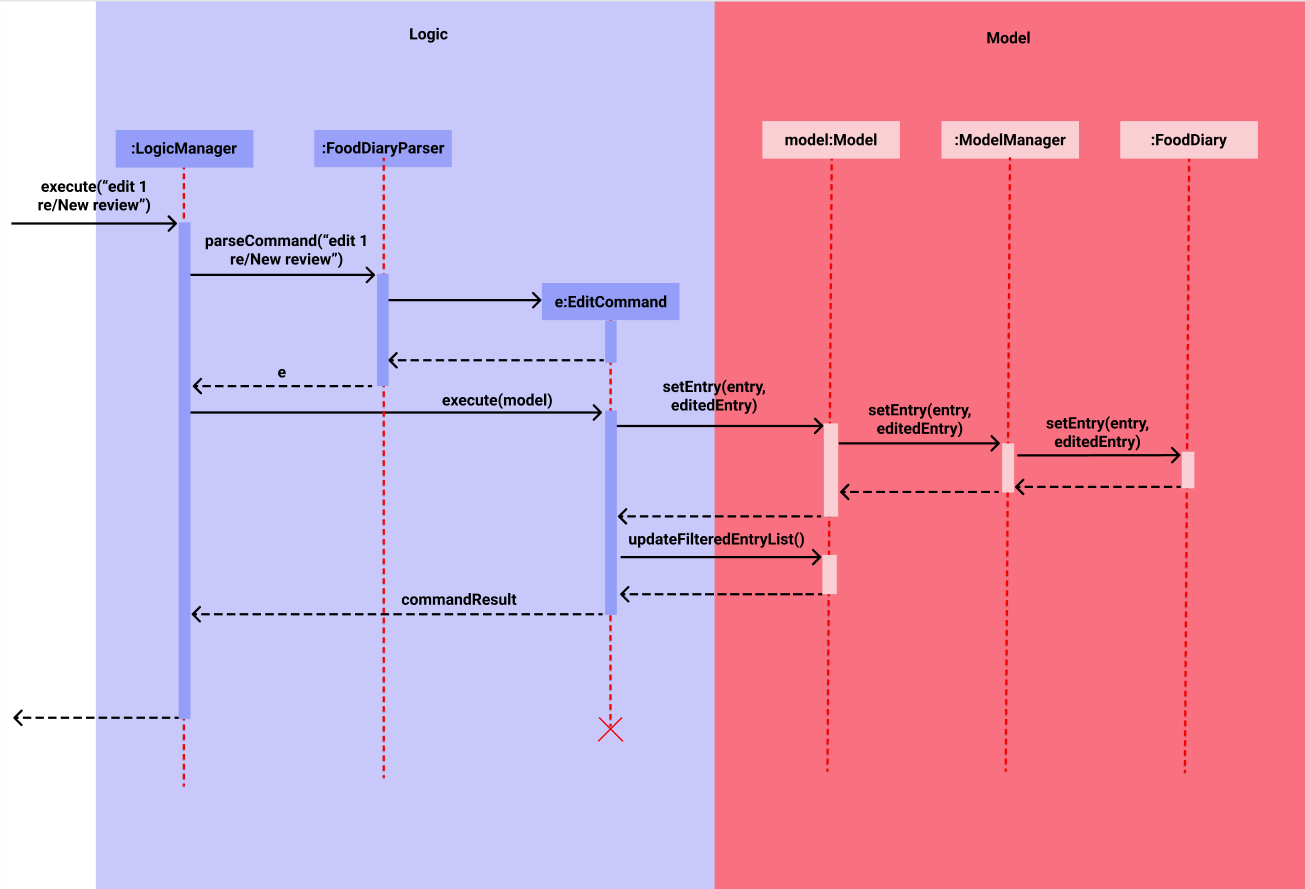
The following activity diagram summarises the events that take place when a user executes the edit
command:
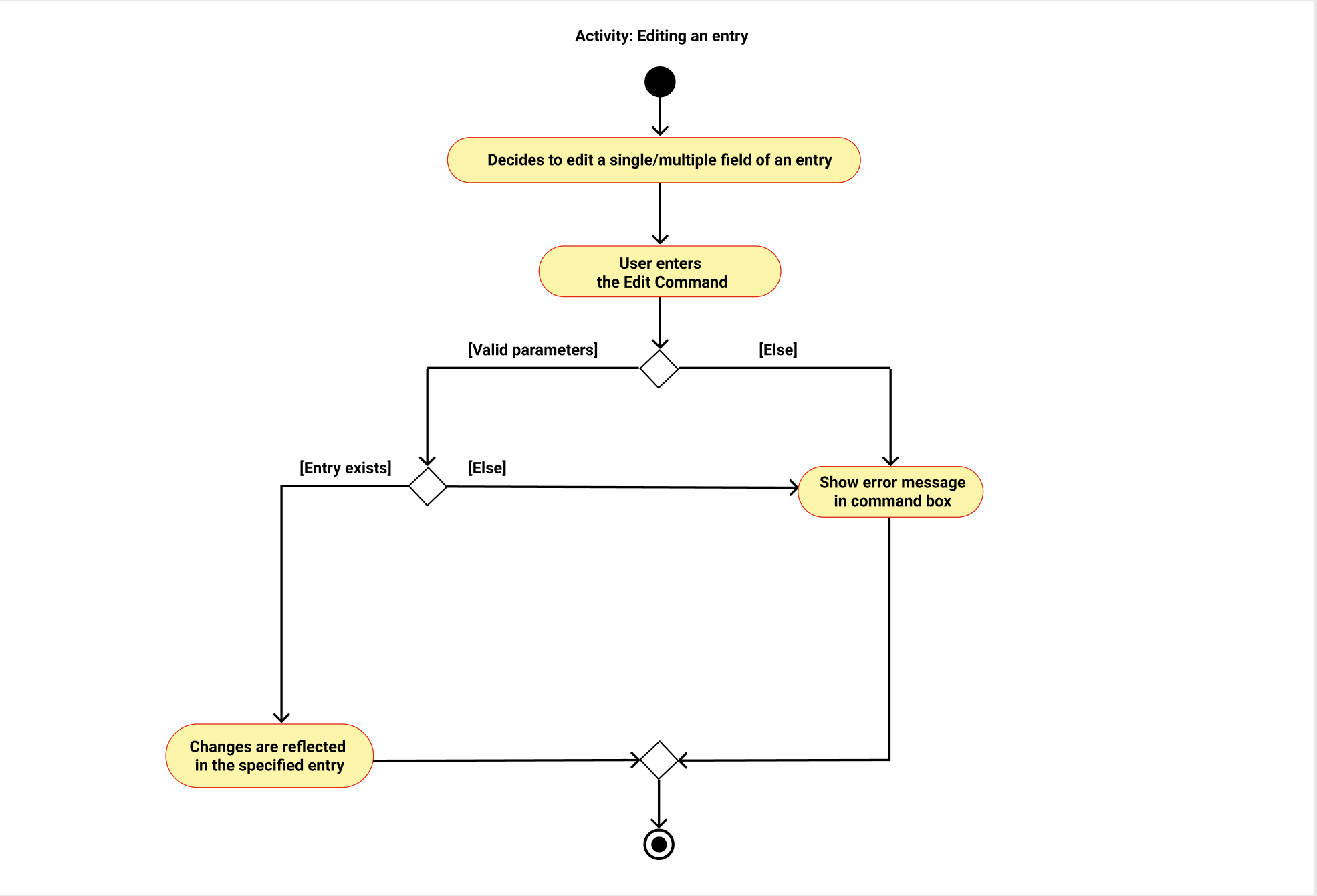
Design Consideration
Aspect: Whether to edit a command in the command line or in a new Ui window
-
Alternative 1 (current choice): Edit entry in command line.
- Pro: View all details of an entry and easily revise them with keyboard shortcuts.
- Con: For entries with lengthy details, typing long commands in the command line fills up the text field space and makes it difficult for editing.
-
Alternative 2: Edit the entry in a new Ui window.
- Pro: Edit is purely done in the command line, which might be convenient for minor changes a user want s to make.
- Con: Edit is not done purely in command line, but rather in a Ui window. This might pose an inconvenience for the user given the added step to edit a field of an entry.
As such, we decided to implement a new feature named
revisefor users to achieve the cons of the current choice foreditand the pros for the alternative.
Help Feature
The help feature primarily helps the user by showing a help guide whenever a user wishes to see it.
-
The help guide is a succinct version of all the commands and keywords for certain input parameters.
-
The help guide also displays examples related to each command for users to quickly get a sense of what each command does.
-
The help guide also contains the link to our User Guide where users can copy the link from and visit for more information.
Given below is an example usage scenario:
Step 1. The user is unsure of what command to execute, or the syntax of the command to execute.
Step 2. The user executes help, which opens up a help guide in a separate window. The user can copy the User Guide URL
and visit the URL for more information.
Step 3. If the user input is invalid, an error message will be displayed in the command box.
An additional HelpWindow is opened when a user enters the help command in the Ui.
The command will be passed into MainWindow#executeCommand(), to which Logic#execute() calls LogicManager#execute() to parse the
user input via FoodDiaryParser#parseCommand(). The user input will be parsed as a ‘Help’ command.
At the end, a HelpWindow is returned.
The following sequence diagram shows how the Help feature works:
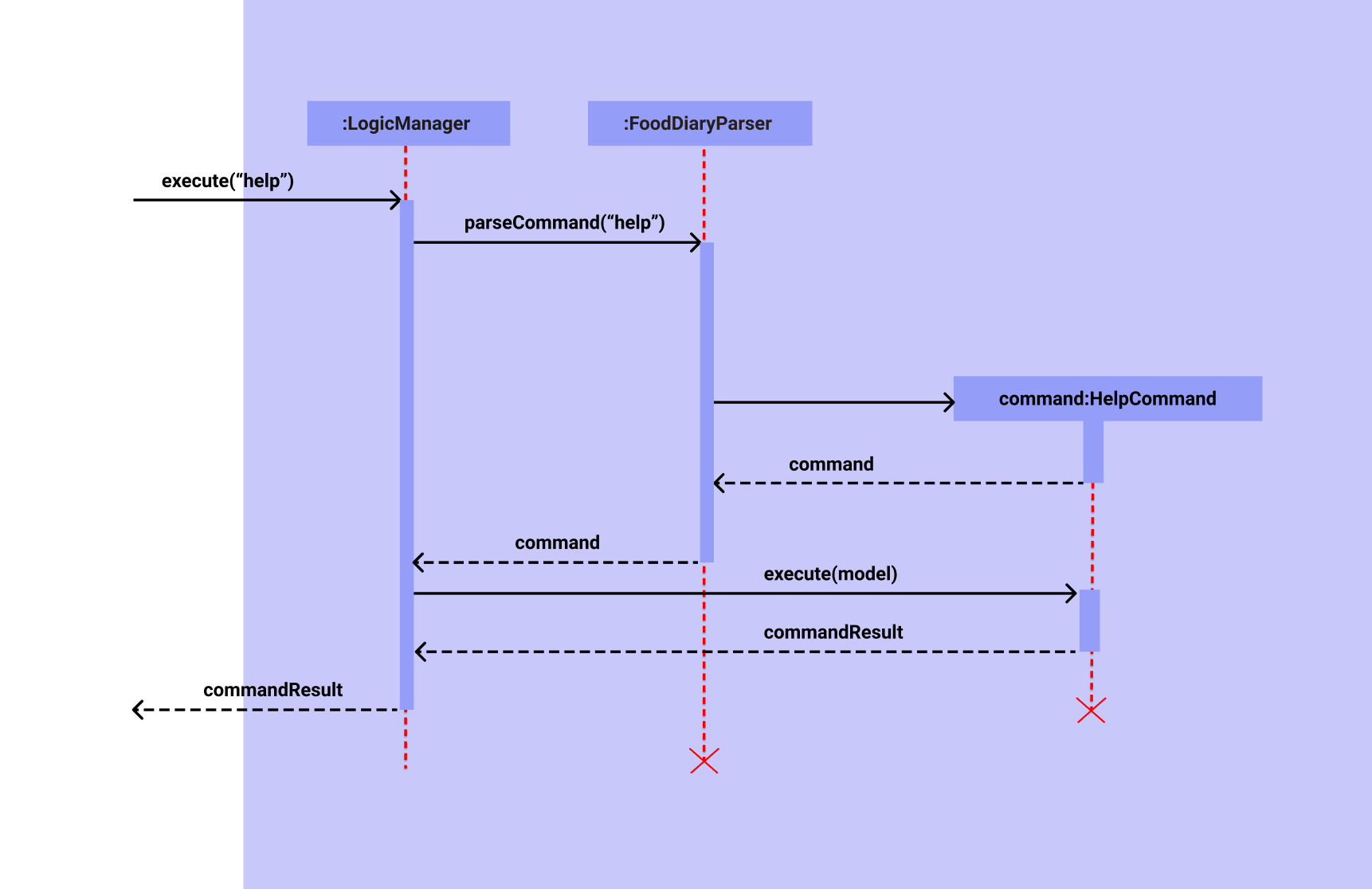
The following activity diagram summarizes what happens when a user executes the help command:

View Feature
view: Allows the user to view a specified entry in a new window, allowing the user to carefully look through
all the details of an entry. This feature is mainly used to read lengthy food reviews which cannot be shown on the Main
Ui window.
Given below is an example usage scenario:
Step 1. The user launches The Food Diary application. Data will be loaded from the storage to the application memory.
The FoodDiary will be populated with a list of Entry, each contains: Name, Address, Price
, Rating, Review, TagCategory and TagSchool.
Step 2. The user executes view <INDEX>, for whichever entry with lengthy reviews he/she wants to view.
Step 3. If the user input is invalid, an error message will be displayed in the command box, If the entry specified do not exist, the filteredEntryList will be empty and no entry will be displayed on the Main Window.
The mechanism works in such a way where after the user enters a command in the Ui, the command will be passed into
MainWindow#executeCommand(), to which Logic#execute() calls LogicManager#execute() to parse the user input via
FoodDiaryParser#parseCommand(). The parsed command will be recognised as a view command and executed to
retrieve all the details related to the specified entry. The result of this execution will be passed back to the Ui and
shown in a new window.
The following sequence diagram shows how the View feature works:

The following activity diagram summarizes what happens when a user executes the view command:
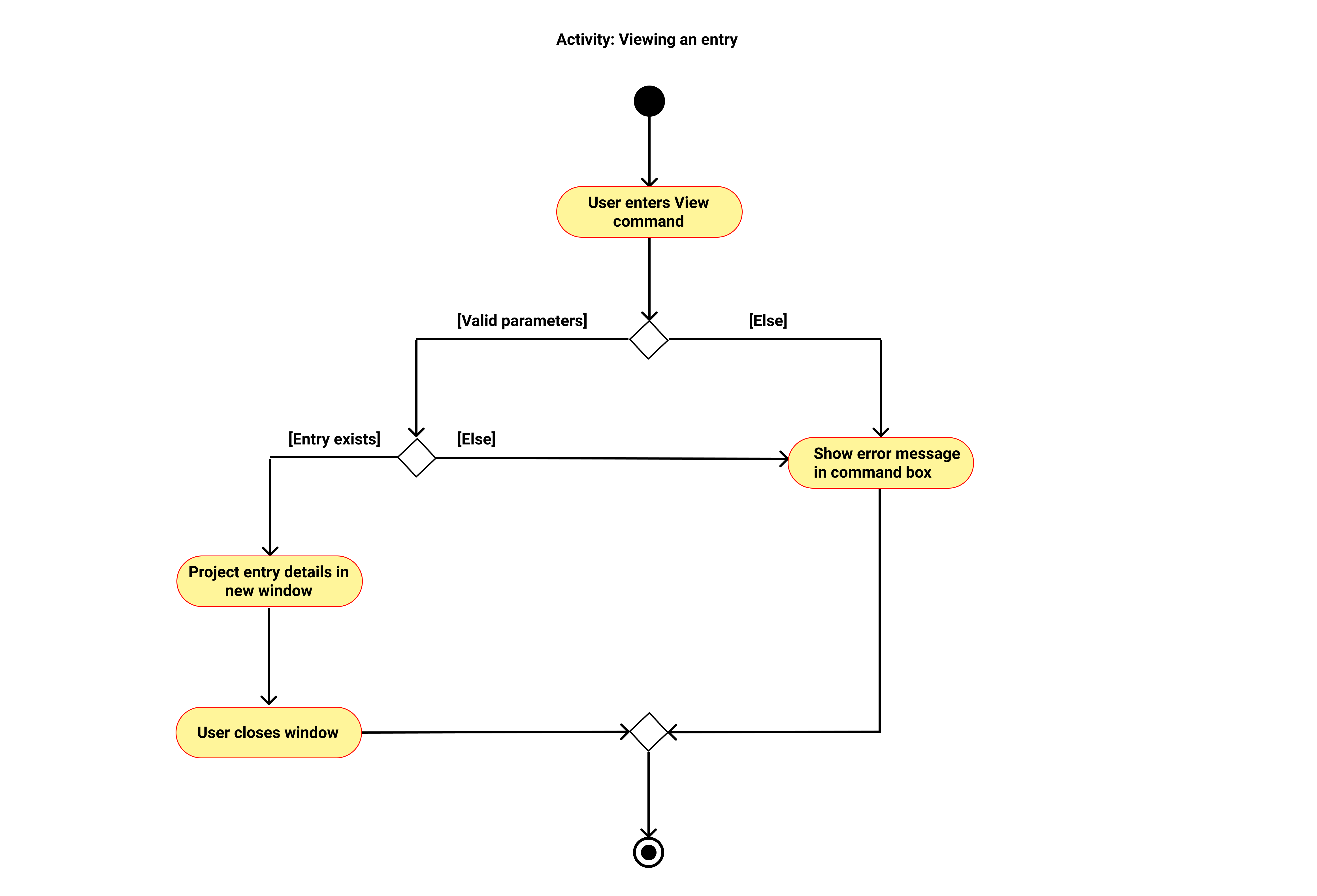
view command.
Design Consideration
Aspect: Whether to view entry with lengthy reviews in the Main Ui or in a new window.
-
Alternative 1 (current choice): View entry with lengthy reviews in a new window.
- Pro: Easier to implement, do not need to deal with complex Ui codes. Entry information looks neater.
- Con: User has to close/minimize the window to return to Main Window.
-
Alternative 2: View entry with lengthy reviews in the Main Ui.
- Pro: Design is integrated within Main Ui, which gives it a cleaner look.
- Con: Difficult to implement, lesser time for testability given the project deadline duration.
Clear Feature
clear: Allows the user to clear entries in The Food Diary.
Given below is an example usage scenario:
Step 1. The user launches The Food Diary application. Data will be loaded from the storage to the application memory.
The FoodDiary will be populated with a list of Entry, each contains: Name, Address, Price
, Rating, Review, TagCategory and TagSchool.
Step 2. The user executes clear to clear all entries in The Food Diary.
This feature was brought over to The Food Diary from AB3. There were not many changes apart from modifying it to clear
entries instead. Similar to other commands, MainWindow#executeCommand() runs, which calls Logic#execute(),
which calls LogicManager#execute() to parse the user input via FoodDiaryParser#parseCommand(). The parsed command will be identified
as a clear command.
Exit Feature
The Exit feature allows a user to close the application.
Given below is an example usage scenario:
Step 1. The user is the midst of using The Food Diary application. The user has finished using the application.
Step 2. The user executes exit and closes the application.
This feature was brought over to The Food Diary from AB3.
There were no changes. Similar to other commands, MainWindow#executeCommand() runs, calling Logic#execute(),
which calls LogicManager#execute() to parse the user input via FoodDiaryParser#parseCommand().
The parsed command will be identified as the exit command.
Documentation, logging, testing, configuration, dev-ops
Appendix A: Challenges Faced
Challenges Faced & Rationales
-
One of the most significant challenges on the creation of The Food Diary was refactoring and redefining classes and methods to match the implementation of a Food Diary, and in doing so do away with previous implementations that would otherwise suggest the implementation of an address book.
-
This thus involved major refactoring of the code base, followed by converting/creating several entities to match a Food Diary, such as the
PricingandRatingclasses etc. pertaining to a journal entry in The Food Diary. -
Creating these new entities entailed creating the appropriate classes in the
Modelpackage to manage and process these new entities in the app’s memory.
-
-
We explored several design options when creating new features such as the
reviseandviewfeatures. We realised that while users could rely majorly on the keyboard to execute most of the app’s features, this was however not the best, since users would miss the capability to view the different fields of their entries in full, which would have otherwise further enhanced their usage of the app.-
This led us to create new separate windows that would pop up and allow users to view/revise the fields of their specified entry in greater detail, without compromising their ability to edit. For
revise, users could choose to select which field to edit by clicking, or by using keyboard shortcuts; this did not compromise the keyboard-intensive interface that users might rely on. -
We nonetheless still implemented the keyboard-based
editfeature, and deemed that it was still useful for users who had minor edits to perform on their specified entry, which would make having to open up a separate window more inconvenient. -
In all, design decisions had to be made, and we put ourselves in the perspectives of our users and implemented features and designs to what we felt best fitted them.
-
-
We constantly questioned ourselves as to how The Food Diary could be catered more towards NUS students.
-
As such, we preserved the user interface element of typing to execute functions/features in The Food Diary, given that our target users, NUS students would be comfortable using the app via keyboard-reliant interface.
-
Additionally, we matched the colour scheme of The Food Diary to subtly reflect the colours of NUS and make The Food Diary appealing to the patronage of NUS students.
-
Entries in the Food Diary featured tags that were based off NUS locations. Given the multitude of eateries dotted around NUS, this would make identifying entries based on NUS locations essential to an NUS student who would have referenced back to previous entries in their usage over the longer term.
-
-
Finally, working together to deliver what we set out to do proved hectic at times of immense commitment from the team to other responsibilities in school. Nonetheless, with good planning, open communication, and a strong sense of ownership for the effort in the work we have done, we have produced what we believe was usable and useful for the NUS students to patronise and enjoy.
Appendix B: Product scope
Target user profile
This product caters to food-fervent NUS students who would ideally benefit from keeping records of food options tasted in the vicinity of NUS.
-
prefer desktop apps over other types
-
can type fast and prefers typing to mouse interactions
-
is reasonably comfortable using CLI apps
-
occasionally prefers to use Ui for certain tasks
Value proposition
Product Scope: The Food Diary will allow NUS foodies to save time and effort when finding places to eat around the NUS vicinity. The Food Diary especially caters to students chiefly on 2 aspects – One, the ability for users to log personal food reviews tagged under different NUS-related location categories for future reference; two, the ability to effortlessly reference food options based on relevant filters in a user-friendly GUI; and three, the option for users to use Commands typed by keyboard in an intuitive GUI to perform tasks quickly.
Appendix C: User stories
Priorities: High (must have) - * * *, Medium (nice to have) - * *, Low (unlikely to have) - *
| Priority | As a/an … | I want to … | So that I can… |
|---|---|---|---|
* * * |
User wanting to add a review of food experience to a particular restaurant | Add a review of food experience | Refer back to the particular element that defined my food experience |
* * * |
User with little patience and time | Add names of places I have visited | Efficiently add a review to a place I have visited |
* * |
User who wants to look at the places I have visited | View the list of experiences I have had | Easily show them to my friends |
* * * |
User trying to decide where to eat | Look at the places i have visited before | Decide where I shall re-visit |
* * * |
User who would like to create custom categories of food place | Add the category of the place | Have a specific view of certain places |
* * * |
User who does not want to visit a place again | Remove the place | Reduce redundant food places in my list |
* * * |
User who wants to remember food ratings | Give a rating on the overall food experience | Gauge/ballpark the satisfaction level I get against other food experiences |
* * * |
User who wants to read lengthy reviews of an entry | Glance through reviews of an entry | Quickly arrive at a conclusion for a food place |
* |
User who wants to see what my friends think of a food place | Glance through my friends’ reviews of the entry of that place | Decide if the food place is pleasant to eat at with my friends |
* * |
User frequently revisiting a place | Add multiple reviews to a single place | Store all my food experiences with the place |
* * |
User who wants to eat good food at an affordable price | Search for places that match both the rating and price that I want | Visit the best food places without overspending |
* * |
User who wants identify a place he/she ate at previously by name | Find entries that match the name of the place I last visited | Judge if I would like to go back to that place and eat there. |
* * * |
User who made a mistake in an entry | Perform revisions and updates to the entry | Keep accurate and up-to-date information of food places |
* * * |
User who is unclear of what to do with the app | Look at a help guide to get familiar with the app usage | Use the app confidently and use it to its fullest extent |
Appendix D: Use cases
(For all use cases below, the System is the Food Diary and the Actor is the user, unless specified otherwise)
UC01: Add an Entry
Preconditions: There are less than 1,000,000 entries in the Food Diary application.
MSS
- User enters details to add an entry to the Food Diary.
-
Food Diary adds a new entry to the app.
Use case ends.
Extensions
- 1a. Food Diary detects invalid command from user.
- 1a1. Food Diary warns user about invalid command syntax.
-
1a2. User enters correct command syntax.
Use case resumes from step 2.
- 2a. Food Diary detects duplicate entry that is already stored in the application.
-
2a1. Food Diary warns user that the entry to be added already exists in the application.
Use case ends.
-
UC02: List all entries
MSS
- User requests to list all entries.
-
Food Diary displays all the entries.
Use case ends.
Extensions
-
1a. Food Diary detects invalid command from user.
- 1a1. Food Diary warns user about wrong syntax.
-
1a2. User enters correct syntax.
Use case resumes from step 2.
-
2a. No entries to display.
- 2a1. Tells users that there are no entries.
-
2a2. User enters correct syntax.
Use case ends.
UC03: Add category
MSS
- User adds a new category.
- Food Diary adds the new category into the app.
-
Food Diary displays the new category added in a tag.
Use case ends.
Extensions
- 1a. Food Diary detects invalid command from user.
- 1a1. Food Diary warns user about wrong syntax.
-
1a2. User enters correct syntax.
Use case resumes from step 2.
- 1b. New category already exists.
-
1b1. Food Diary tells user that the category already exists.
Use case ends.
-
UC04: Add on review(s) and/or price to a specified Food Diary Entry
MSS
- User requests to add a review(s) and/or a price to a specified entry.
- Food Diary checks for the specified entry.
-
Food Diary adds review(s) and/or a price to the specified entry.
Use case ends.
Extensions:
- 1a. Food Diary detects invalid command from user.
- 1a1. Food Diary warns user about invalid command syntax.
-
1a2. User enters correct command.
Use case resumes from step 2.
- 2a. Specified Food Diary entry not found
-
2a1. Food Diary tells user that the specified entry is invalid.
Use case ends.
-
UC05: Delete an Entry
MSS
- User requests to delete a Food Diary entry.
-
Food Diary removes the entry from its database.
Use case ends.
Extensions:
- 1a. Food Diary detects invalid command from user.
- 1a1. Food Diary warns user about invalid command syntax.
-
1a2. User enters a valid command.
Use case resumes from step 2.
- 2a. Specified Food Diary entry not found
-
2a1. Food Diary tells user that the specified entry is invalid.
Use case ends.
-
UC06: Find entry(-ies)
MSS
- User enters keyword(s) to be used to search for entry(-ies).
-
Food Diary shows entry/all entries matching user requirement(s).
Use case ends.
Extensions:
- 1a. Food Diary detects invalid command from user.
- 1a1. Food Diary warns user about wrong syntax.
- 1a2. User enters correct syntax.
Use case resumes from step 2.
UC07: Find specific entry(-ies)
MSS
- User enters keyword(s) to specify requirement(s) for entry(-ies).
-
Food Diary shows entry/all entries matching user requirement(s).
Use case ends.
Extensions:
- 1a. Food Diary detects invalid command from user.
- 1a1. Food Diary warns user about wrong syntax.
- 1a2. User enters correct syntax.
Use case resumes from step 2.
UC08: Get Help
MSS
- User requests to get help on what commands to use.
- Food Diary returns a succint help guide with the information he needs.
- User reads the help guide and is now familiar with the commands to use.
- User requests to close help guide after use.
-
Food Diary closes help guide.
Use case ends.
Extensions:
- 1a. Food Diary detects invalid command from user.
- 1a1. Food Diary warns user about wrong syntax.
-
1a2. User enters correct syntax.
Use case resumes from step 2.
- 2a. User reads help guide but is still unclear of what command to use.
- 2a1. User requests to see User Guide for more information
-
2a2. Food Diary returns User Guide link for the user to access
Use case resumes from step 3.
UC09: View an Entry
MSS
- User requests to view a specific entry.
- Food Diary checks requested entry.
-
Food Diary shows specified entry details.
Use case ends.
Extensions:
- 1a. Food Diary detects invalid command from user.
- 1a1. Food Diary warns user about wrong syntax.
-
1a2. User enters correct syntax.
Use case resumes from step 2.
- 2a. Food Diary detect a non-existent index in list.
-
2a1. Food Diary tells user that no entry was found.
Use case ends.
-
UC10: Revise an Entry
MSS
- User requests to revise a specific entry.
- Food Diary checks requested entry.
-
Food Diary allows user to make revisions to the entry.
Use case ends.
Extensions:
- 1a. Food diary detects invalid command from user.
- 1a1. Food Diary warns user about wrong syntax.
-
1a2. User enters correct syntax.
Use case resumes from step 2.
- 2a. Food Diary detect a non-existent index in list.
-
2a1. Food Diary tells user that no entry was found.
Use case ends.
-
UC11: Edit an Entry
MSS
- User requests to edit entry field(s) of a specific entry due to minor errors.
-
Food Diary edits the entry with the updated field(s).
Use case ends.
Extensions:
- 1a. Food Diary detects invalid command from user.
- 1a1. Food Diary warns user about wrong syntax.
-
1a2. User enters correct syntax.
Use case resumes from step 2.
- 1b. User keys in non-existent index in list
-
1b1. Food Diary tells user that no entry was found.
Use case ends.
-
UC12: Clear
MSS
- User requests to clear all entries.
-
Food Diary clears all entries.
Use case ends.
Extensions:
- 1a. Food Diary detects invalid command from user.
- 1a1. Food Diary warns user about wrong syntax.
-
1a2. User enters correct syntax.
Use case resumes from step 2.
UC13: Exit
MSS
- User exits.
-
Food Diary closes and data is saved.
Use case ends.
Extensions:
- 1a. Food Diary detects invalid command from user.
- 1a1. Food Diary warns user about wrong syntax.
-
1a2. User enters correct syntax.
Use case ends.
Appendix E: Non-Functional Requirements
Non-functional requirements specify the constraints under which the system for The Food Diary is developed and operated. The Food Diary system is made up of the front-end, which is interchangeably referred to as the User interface (Ui), and the back-end, which handles data management and operations. The app is interchangeably referred to as the system.
Technical requirements
- The system should be operable on Windows, MacOS and Linux operating systems, with Java 11 or above installed.
Performance requirements
- The system should be loaded up within 2 seconds or less.
- The Ui should appear within 2 seconds or less and be responsive to User input.
- The back-end should be responsive to processing User input at the same time the Ui appears.
- The back-end should be able to handle 1,000 or more data entries (Food Diary entries) without noticeable sluggishness in performance for typical usage.
Usability requirements
- The user should have access to a keyboard, and be proficient with typing alphanumeric English characters for commands to accomplish most of the usages of The Food Diary.
Project scope
- The system should mainly comprise the handling of entry-addition, deletion, and listing for The Food Diary.
- The system would not be responsible for features involving multiple users.
Scalability requirements
- The system can handle a larger user base with many more food diary entries being added to it.
- Program is extendable for future addition of features easily.
Other Noteworthy Points
- The system should preserve data keyed in by the user upon exiting.
Appendix F: Glossary
The glossary serves to ensure that all stakeholders, including users, have a common understanding of the noteworthy terms, and abbreviations.
- Sluggishness: The system starts to be slow in displaying user input when typed, and processing user input when entered.
Appendix G: Instructions for manual testing
Given below are instructions to test the app manually.
Launch and Shutdown
-
Initial launch
-
Download the jar file and copy into an empty folder.
-
Double-click the jar file
Expected: Shows the GUI with a set of sample food Diary entries. The window size may not be optimum.
-
-
Saving window preferences
-
Resize the window to an optimum size. Move the window to a different location. Close the window.
-
Re-launch the app by double-clicking the jar file.
Expected: The most recent window size and location is retained.
-
Add an entry
-
Add an entry with the provided details
-
Prerequisite:
listentries to ensure that the entry going to be added in not already displayed in the Food Diary application. -
Test case:
add n/Subway ra/5 p/6 re/I like this food a lot! a/3155 Commonwealth Ave W, Singapore 129588 c/FastFood c/Vegan s/SOCExpected: Adds an entry with name Subway, 5/5 Rating, ‘I like this food a lot!’ review, 3155 Commonwealth Ave W, Singapore 129588 address, FastFood and Vegan categories and a SOC. A new entry will be shown in the entry list panel.
-
Test case:
add n/Subway ra/7 p/6 re/I like this food a lot! a/3155 Commonwealth Ave W, Singapore 129588 c/FastFood c/Vegan s/SOCExpected: Invalid rating error will be shown in the result display. Entry will not be added.
-
Test case:
add n/Subway ra/5 p/1000 re/I like this food a lot! a/3155 Commonwealth Ave W, Singapore 129588 c/FastFood c/Vegan s/SOCExpected: Invalid price error will be shown in the result display. Entry will not be added.
-
Test case:
add n/Subway ra/5 p/6 re/ a/3155 Commonwealth Ave W, Singapore 129588 c/FastFood c/Vegan s/SOCExpected: Invalid review error will be shown in the result display. Entry will not be added.
-
Test case:
add n/Subway ra/5 p/6 re/I like this food a lot! a/ c/FastFood c/Vegan s/SOCExpected: Invalid address error will be shown in the result display. Entry will not be added.
-
Test case:
add n/Subway ra/5 p/6 re/I like this food a lot! a/Deck c/FastFood c/Math s/SOCExpected: A list of valid categories will be shown in the result display. Entry will not be added.
-
Test case:
add n/Subway ra/5 p/6 re/I like this food a lot! a/3155 Commonwealth Ave W, Singapore 129588 c/FastFood c/Vegan s/PrimaryExpected: A list of valid schools will be shown in the result display. Entry will not be added.
-
Other incorrect add commands to try:
add n/Subway ra/5 p/6 re/I like this food a lot! a/3155 Commonwealth Ave W, Singapore 129588 c/FastFood c/Vegan s/SOC
followed byadd n/Subway ra/5 p/6 re/I like this food a lot! a/3155 Commonwealth Ave W, Singapore 129588 c/FastFood c/Vegan s/SOC(duplicate entry)
-
Add on to an entry
-
Add on to an entry with the provided details
-
Prerequisite:
listto select the entry you want to add on details to. There must be at least one entry displayed. -
Test case:
addon 1 re/I like this food a lot! p/7Expected: Add on the review “I like this food a lot!” and a price of $7 to the existing price/price range shown in the entry (price range updates if the input price is out of the initial price range displayed in the entry). Specified Entry will be updated with the addon on fields.
-
Test case:
addon 1Expected: Error message “At least one field to add-on must be provided.” will be shown in the result display. Nothing will be added on to the specified entry.
-
Test case:
addon 1 re/Expected: Invalid review error will be shown in the result display. Nothing will be added on to the specified entry.
-
Test case:
addon 1 re/Good Food p/1000Expected: Invalid price error will be shown in the result display. Nothing will be added on to the specified entry.
-
Other incorrect
addoncommands to try:addon 10000000000 re/Good Food(invalid index)
-
Delete an Entry
-
Delete a booking specified by booking ID.
-
Prerequisite:
listall entries to find out the name of the entry to delete -
Test case:
delete 1Expected: Delete entry at index 1. Success message and deleted entry details shown in the result display.
-
Test case:
delete x(where x is non-existent booking ID)Expected: Error of invalid entry shown in result display. No entry is deleted.
-
Other incorrect
deletecommands to try:delete,delete StarbucksExpected: Invalid command format error. No entry is deleted.
-
Find entries
-
Finding for entries using the
findcommand-
Prerequisite: the food diary should contain all default entries
-
Test case:
find 4/5Expected:
- All entries shown with a rating of 4/5.
- Success message displayed informing the user of the number of entries found.
- 4 default entries will be shown.
-
Test case:
find $7Expected:
- All entries shown with a price of $7, or a range of price that contains $7.
- Success message displayed informing the user of the number of entries found.
- 1 default entry will be shown.
-
Test case:
find western 5/5 $5-10Expected:
- All entries shown which contain at least one of the three keywords provided.
- Success message displayed informing the user of the number of entries found.
- 9 default entries will be shown.
-
Test case:
find 3/7Expected:
- All entries shown which contain the provided keyword:
3/7, if any. - Success message displayed informing the user of the number of entries found.
- Suggestion message displayed informing the user of a possible typo for a rating search, providing directions to correct the typo.
- 0 default entries will be shown.
- All entries shown which contain the provided keyword:
-
Test case:
find $5-Expected:
- All entries shown which contain the provided keyword:
$5-, if any. - Success message displayed informing the user of the number of entries found.
- Suggestion message displayed informing the user of a possible typo for a price search, providing directions to correct the typo.
- 0 default entries will be shown.
- All entries shown which contain the provided keyword:
-
Test case:
find 3/7 $5-Expected:
- All entries shown which contain either of the keywords provided, if any.
- Success message displayed informing the user of the number of entries found.
- Suggestion message displayed informing the user of possible typos for a rating search, and a price search, providing directions to correct the typos.
- 0 default entries will be shown.
-
Find specific entries
-
Finding for entries using the
findallcommand-
Prerequisite: the food diary should contain all default entries
-
Test case:
findall 4/5Expected:
- All entries shown with a rating of 4/5.
- Success message displayed informing the user of the number of entries found.
- 4 default entries will be shown.
-
Test case:
findall $7Expected:
- All entries shown with a price of $7, or a range of price that contains $7.
- Success message displayed informing the user of the number of entries found.
- 1 default entry will be shown.
-
Test case:
findall western 5/5 $5-10Expected:
- All entries shown which contain all three keywords provided.
- Success message displayed informing the user of the number of entries found.
- 2 default entries will be shown.
-
Test case:
findall 4/5 5/5Expected:
- All entries shown which contain both of the keywords provided, if any.
- Success message displayed informing the user of the number of entries found.
- 0 default entries will be shown.
-
Test case:
findall 3/7Expected:
- All entries shown which contain the provided keyword:
3/7, if any. - Success message displayed informing the user of the number of entries found.
- Suggestion message displayed informing the user of a possible typo for a rating search, providing directions to correct the typo.
- 0 default entries will be shown.
- All entries shown which contain the provided keyword:
-
Test case:
findall $5-Expected:
- All entries shown which contain the provided keyword:
$5-, if any. - Success message displayed informing the user of the number of entries found.
- Suggestion message displayed informing the user of a possible typo for a price search, providing directions to correct the typo.
- 0 default entries will be shown.
- All entries shown which contain the provided keyword:
-
Test case:
findall 3/7 $5-Expected:
- All entries shown which contain both of the keywords provided, if any.
- Success message displayed informing the user of the number of entries found.
- Suggestion message displayed informing the user of possible typos for a rating search, and a price search, providing directions to correct the typos.
- 0 default entries will be shown.
-
View an entry
-
View an expanded view of an entry with lengthy review
-
Prerequisite: Must have entries listed out in the Main Window
-
Test Case: Correct command with valid parameters:
view 1(provided that entry of index 1 already exists)Expected: A window pops up which shows all details of the specified entry.
-
Test Case: Command without parameters:
viewExpected: User will be notified that invalid command format is provided. The command box will show the correct syntax for
viewcommand.
-
Test Case: Command not in lower-case:
ViEw 1(provided that entry of index 1 already exists)Expected: User will be notified about unknown command in the command box.
-
Test Case: Correct command but with non-existent index:
view 100000(provided that entry of index 100000 do not exists)Expected: User will be notified of invalid command, and the number of entries in The Food Diary.
-
Revise an Entry
-
Edit the
Name,Rating,Price,Address,Reviews,School(s),Category(s)- Prerequisite: Have a list of Entries or at least 1 Entry in view. In command line, execute
Revise <Index>.Indexrefers to index of Entry to revise in view.
-
Test case: Under Name, change name to
McDonalds. ClickRevisebutton.Expected: Name of entry to be changed to
McDonalds, Revise window to close and Main Window to show a list of all entries. Success Message leads withEdited Entry: ...shown in status bar.
-
Test case: Under Rating, change rating to
2. ClickRevisebutton.Expected: Rating of entry changes to 2/5, Revise window to close and Main Window to show a list of all entries. Success Message leads with
Edited Entry: ...shown in status bar.
-
Test case: Under Price, change to
5. ClickRevisebutton.Expected: Price of entry to be changed to
5, Revise window to close and Main Window to show a list of all entries. Success Message leads withEdited Entry: ...shown in status bar.
-
Test case: Under Address, change to
Computing Drive. ClickRevisebutton.Expected: Address of entry to be changed to
Computing Drive, Revise window to close and Main Window to show a list of all entries. Success Message leads withEdited Entry: ...shown in status bar.
-
Test case: Under Categories, add
western. ClickRevisebutton.Expected: Categories of entry to add
Western, Revise window to close and Main Window to show a list of all entries. Success Message leads withEdited Entry: ...shown in status bar.
-
Test case: Under Categories, add to
soc. ClickRevisebutton.Expected: Categories of entry to add
SOC, Revise window to close and Main Window to show a list of all entries. Success Message leads withEdited Entry: ...shown in status bar.
-
Other valid test cases to try: Combine any of the above testcases before pressing
Revise. All changes should be accounted for. - Other invalid test cases to try: Use non-alphanumeric names, change name and address to be the same as an Entry that
already exists, invalid Categories
westenand SchoolsCom.
- Prerequisite: Have a list of Entries or at least 1 Entry in view. In command line, execute
Edit an entry
-
Edit the
Name,Rating,Price,Address,Reviews,School(s),Category(-ies)- Prerequisite: Have a list of Entries or at least 1 Entry in view. In command line,
execute
edit <INDEX> <KEYWORD> ....
-
INDEXrefers to index of Entry to revise in view.
-
- The following test cases will test different permutations and numbers of
KEYWORD(s).
-
Test case:
edit 1 n/McDonaldsExpected:
- First entry has named changed to “McDonalds”.
- All entries remain shown
- Success message displayed informing the user of change.
-
Test case:
edit 2 ra/0Expected:
- Second entry has rating changed to 0. (0/5)
- All entries remain shown (with the first entry remaining edited as done previously).
- Success message displayed informing the user of change.
-
Test case:
edit 3 a/50 West Coast RoadExpected:
- Third entry has address changed to “50 West Coast Road”.
- All entries remain shown (with all entries updated previously).
- Success message displayed informing the user of change.
-
Test case:
edit 4 re/I had a great time here.Expected:
- Fourth entry has review changed to “I had a great time here”.
- All entries remain shown (with all entries updated previously).
- Success message displayed informing the user of change.
-
Test case:
edit 5 p/20Expected:
- Fifth entry has price changed to “20”. ($20)
- All entries remain shown (with all entries updated previously).
- Success message displayed informing the user of change.
-
Test case:
edit 1 n/Hwangs ra/4 p/7 a/NUS re/Korean food makes me happy. s/Utown c/KoreanExpected:
- First entry has name changed to “Hwangs”, rating changed to “4” (4/5), price changed to “7” ($7), review changed to “Korean food makes me happy.”, school location tags changed to “UTOWN”, and food category changed to “Korean”.
- All entries remain shown (with all entries updated previously).
- Success message displayed informing the user of change.
-
Test case:
edit 1 c/Korean c/OthersExpected:
- First entry has food category changed to “Korean” and “Others”.
- All entries remained shown (with all entries updated previously).
- Success message displayed informing the user of change.
-
Test case:
edit -13 c/Korean c/OthersExpected:
- Error message will be thrown, warning users that the index of the entry is out of bounds.
- All entries remain shown (with all entries updated previously).
- Prerequisite: Have a list of Entries or at least 1 Entry in view. In command line,
execute
Clear all entries
-
Remove all entries from The Food Diary
-
Prerequisite: None
-
Test Case: Correct command:
clearExpected: Success message will show up in command box informing user that all entries are cleared.
-
Test Case: Command not in lower-case:
cLeArExpected: User will be notified about unknown command in the command box.
-
UI Mockup
